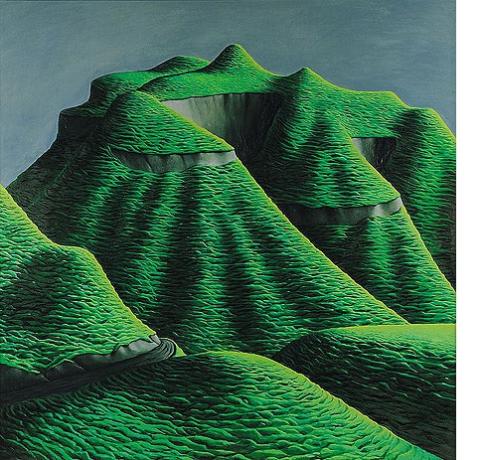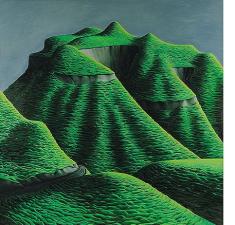Michael Smither (NZ)
Hills of Tongaporutu, 1972
Tongaporutu is a small pretty coastal settlement 67 kilometres north of New Plymouth at the mouth of the Mokau River lined with picturesque old-style family baches. Michael Smither, as we would expect, gives us a different vision of the place. The folksy charm of Smither’s rural landscapes and domestic scenes have long held the power to conjure warm feels of familiarity and humour. They are homely images. But he is also the quiet master of New Zealand’s unhomely (unheimlich), creating ripples of something repressed or denied across the calm exterior of our everyday.
In Hills of Tongaporutu this is most evident in the way he has used the intensity of green to suggest a quite-literally saturated landscape that is slumping ever downwards towards river and sea, exposing the grey subsoil in over-grazed pastureland; and in my imagination the artist takes us into some uncanny undercurrent with the slits of grey which look much like the eye-slits of hooded subterranean creatures.
Hills of Tongaporutu comes in the middle of an incredibly productive two decades for the artist after he moved back to his home town of New Plymouth in 1962 to take up a role as husband, father and fulltime painter. Smither recalls: “It was prolific out of necessity. The prices that one got for paintings in those days were between 12 guineas and … 30 guineas [… and] I had to have, on average, about three or four exhibitions a year of 20 or 30 paintings to meet our financial needs.”
This necessity for productivity did not however dull Smither’s eye, nor his passion for paintings that convey something deeper than intriguing forms and beguiling subjects. Perhaps there is a glimpse of what lies beneath the liquefying green of the hills of Tongaporutu in Smither’s story of the time he decided to walk around the coast from New Plymouth to Wanganui. It took 9 days and in the end he couldn’t take anymore, not because he was tired, but because of what he saw and felt: “The Taranaki environment is so powerful that it’s hard to show that they have had an effect on it, but they have. The evidence of pollution was all the way along the coast. Just about everywhere you went, there were fences hanging over cliffs and waterfalls of dirty streams. It was just appalling. The most miserable bloody walk I’ve ever taken.”
Michael Smither, Hills of Tongaporutu, 1972, oil on board, 1210 x 1210.
Essay commissioned by International Art Centre, Parnell, Auckland, NZ; and published in Selected works from the Fletcher Trust Collection, 10 September 2014 (August 2014).

